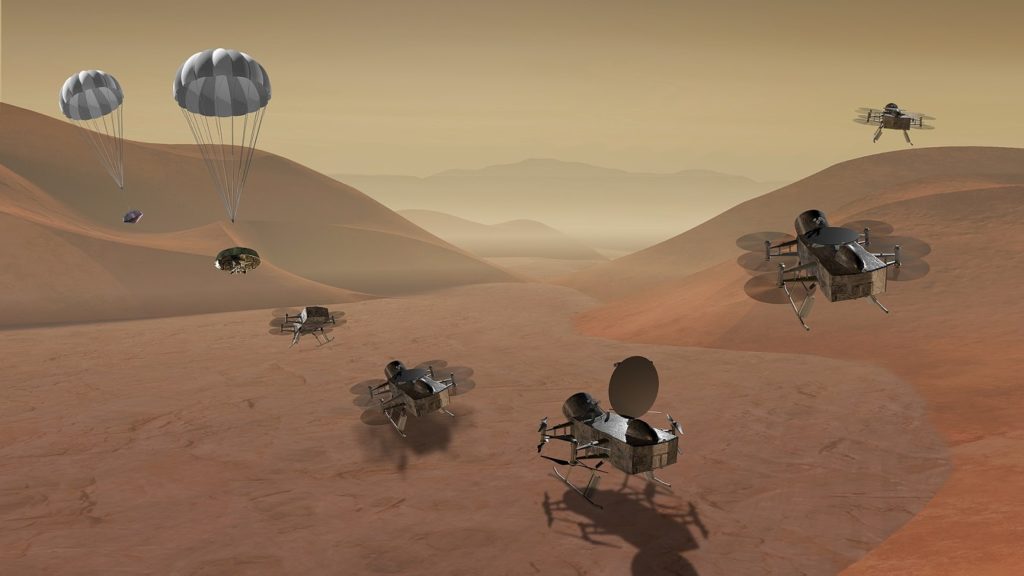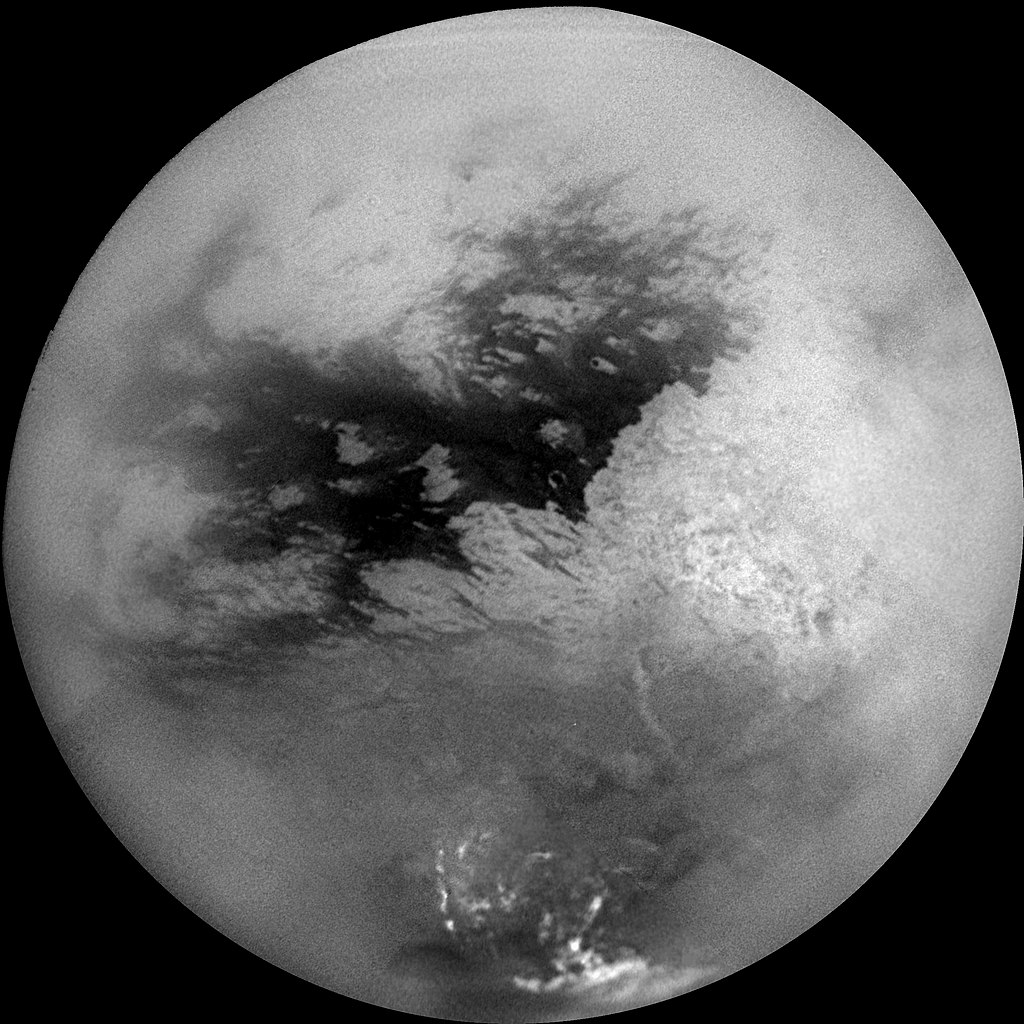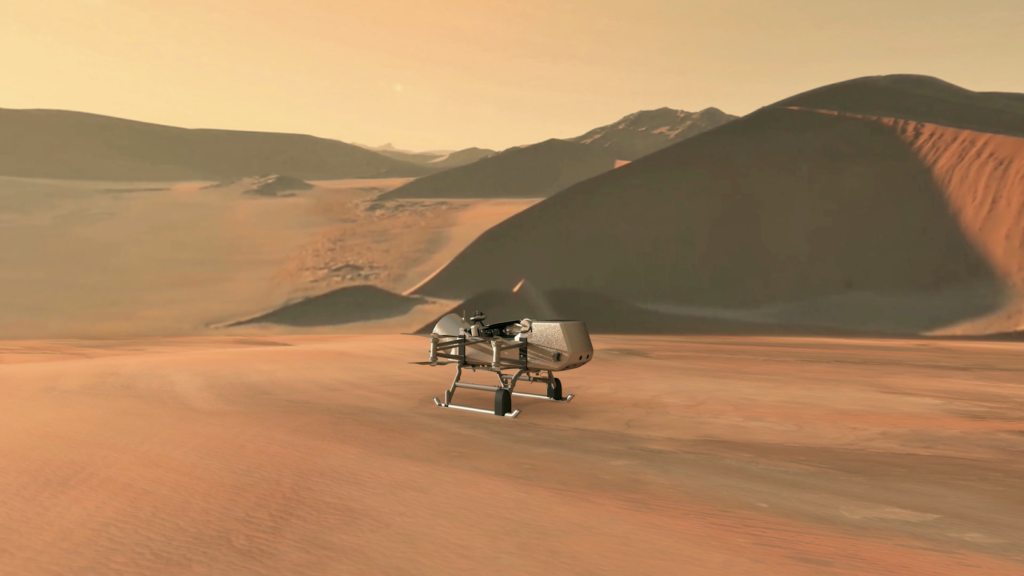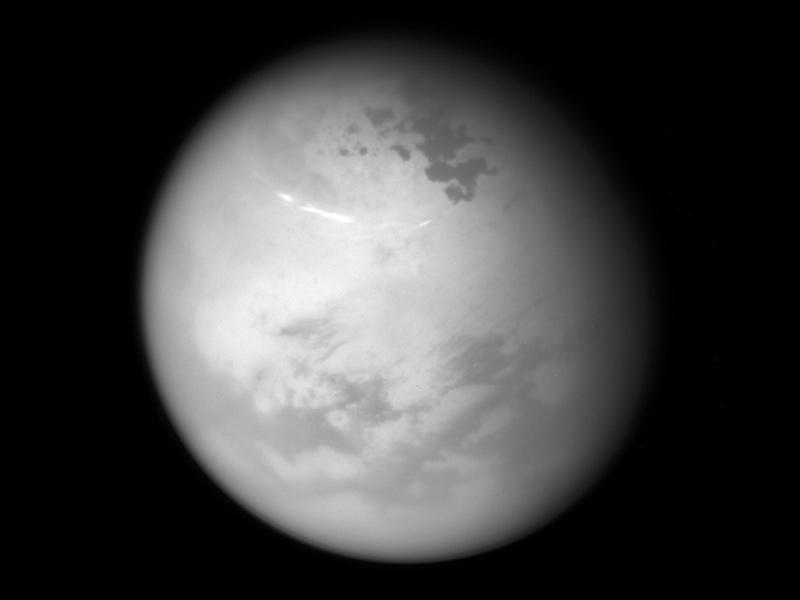Ken Kremer — SpaceUpClose.com & RocketSTEM – 7 July 2019
CAPE CANAVERAL, FL – NASA has selected a bold and daring mission named Dragonfly to send the first ever quadcopter to fly on another world – namely to Saturn’s moon Titan searching for signs of life because it is rich in organic molecules – the building blocks of life.
Dragonfly counts as NASA’s next mission to the outer solar system and will follow in the footsteps and build on the discoveries of the Cassini Saturn orbiter.
“NASA has announced that our next destination in the solar system is the unique, richly organic world Titan. Advancing our search for the building blocks of life, the Dragonfly mission will fly multiple sorties to sample and examine sites around Saturn’s icy moon,” NASA says.
Dragonfly is an exciting mission and exactly what we need to advance NASA’s astrobiology in search of life beyond Earth, in this authors opinion – a Ph.D. organic chemistry researcher for more than 3 decades.
Titan is the most earthlike body in our solar system and possesses all the ingredients needed for life to start and evolve – namely water, organic molecules and energy in the form of light.
Titan is the only solar system body besides Earth with a thick atmosphere – comprised of nitrogen.
In fact Titan’s atmospheric pressure is 4 times Earth whereas Mars is less than one percent of Earth’s.
Titan is rich in organic molecules strewn about on its surface.
Titan also possesses lakes of methane and ethane- the simplest organic molecules. Thus its perfect for mixing molecules which could interact and potentially grow in size, molecular weight and complexity.
Titan is perfect place to look for prebiotic chemistry – although there is no evidence for life at this time.
Dragonfly is a mission unlike any other in the history of NASA or humanity and is truly groundbreaking.
It will sample and analyze Titan’s atmosphere and dune fields in dozens of locations in search of signatures of life with an array of state of the art science instruments.
“With the Dragonfly mission, NASA will once again do what no one else can do,” said NASA Administrator Jim Bridenstine.
“Visiting this mysterious ocean world could revolutionize what we know about life in the universe. This cutting-edge mission would have been unthinkable even just a few years ago, but we’re now ready for Dragonfly’s amazing flight.”
Dragonfly will launch in about 7 years time in 2026 on an 8 year interplanetary trek to Saturn with arrival in 2034.
The launch vehicle is yet to be selected.
Watch this cool animation showing the Dragonfly mission landing sequence:
Video Caption: New Dragonfly Mission Flying Landing Sequence. NASA’s Dragonfly rotorcraft-lander is seen approaching Saturn’s exotic moon Titan in this animation. Taking advantage of Titan’s dense atmosphere and low gravity, Dragonfly will explore dozens of locations across
the icy world, sampling and measuring the compositions of Titan’s organic surface materials to characterize the habitability of Titan’s environment and investigate the progression of prebiotic chemistry. Credit: NASA/JHU-APL
“Dragonfly will launch in 2026 and arrive in 2034. The rotorcraft will fly to dozens of promising locations on Titan looking for prebiotic chemical processes common on both Titan and Earth. Dragonfly marks the first time NASA will fly a multi-rotor vehicle for science on another
planet; it has eight rotors and flies like a large drone. It will take advantage of Titan’s dense atmosphere – four times denser than Earth’s – to become the first vehicle ever to fly its entire science payload to new places for repeatable and targeted access to surface materials.”
 |
|
Graphic shows NASA’s Dragonfly mission arriving on Saturn’s moon Titan, and flying in its atmosphere. Credit: NASA
|
Here is more from NASA:
“Titan is an analog to the very early Earth, and can provide clues to how life may have arisen on our planet. During its 2.7-year baseline mission, Dragonfly will explore diverse environments from
organic dunes to the floor of an impact crater where liquid water and complex organic materials key to life once existed together for possibly tens of thousands of years. Its instruments will study how far prebiotic chemistry may have progressed. They also will investigate the moon’s atmospheric and surface properties and its subsurface ocean and liquid reservoirs. Additionally,
instruments will search for chemical evidence of past or extant life.
Dragonfly took advantage of 13 years’ worth of Cassini data to choose a calm weather period to land, along with a safe initial landing site and scientifically interesting targets. It will first land at the equatorial “Shangri-La” dune fields, which are terrestrially similar to the linear dunes in Namibia in southern Africa and offer a diverse sampling location. Dragonfly will explore this region in short flights, building up to a series of longer “leapfrog” flights of up to 5 miles (8 kilometers), stopping along the way to take samples from compelling areas with diverse geography. It
will finally reach the Selk impact crater, where there is evidence of past liquid water, organics – the complex molecules that contain carbon, combined with hydrogen, oxygen, and nitrogen – and energy, which together make up the recipe for life.
The lander will eventually fly more than 108 miles (175 kilometers) – nearly double the distance traveled to date by all the Mars rovers combined.
 |
|
Shangri-La is the large, dark region at the center of this infrared
image of Titan. Credit: NASA |
“Titan is unlike any other place in the solar system, and Dragonfly is like no other mission,” said Thomas Zurbuchen, NASA’s associate administrator for Science at the agency’s Headquarters in Washington.
“It’s remarkable to think of this rotorcraft flying miles and miles across the organic sand dunes of Saturn’s largest moon, exploring the processes that shape this extraordinary environment. Dragonfly will visit a world filled with a wide variety of organic compounds, which are the building blocks of life and could teach us about the origin of life itself.”
Titan has a nitrogen-based atmosphere like Earth. Unlike Earth, Titan has clouds and rain of methane. Other organics are formed in the atmosphere and fall like light snow. The moon’s weather and surface processes have combined complex organics, energy, and water similar to
those that may have sparked life on our planet.
Titan is larger than the planet Mercury and is the second largest moon in our solar system. As it orbits Saturn, it is about 886 million miles (1.4 billion kilometers) away from the Sun, about 10
times farther than Earth. Because it is so far from the Sun, its surface temperature is around -290 degrees Fahrenheit (-179 degrees Celsius). Its surface pressure is also 50 percent higher than Earth’s.
Dragonfly was selected as part of the agency’s New Frontiers program, which includes the New Horizons mission to Pluto and the Kuiper Belt, Juno to Jupiter, and OSIRIS-REx to the asteroid Bennu.
Dragonfly is led by Principal Investigator Elizabeth Turtle, who is based at Johns Hopkins University’s Applied Physics Laboratory in Laurel, Maryland. New Frontiers supports missions that have been identified as top solar system exploration priorities by the planetary community. The program is managed by the Planetary Missions Program Office at NASA’s Marshall Space Flight Center in Huntsville, Alabama, for the agency’s Planetary Science Division in Washington.
“The New Frontiers program has transformed ourunderstanding of the solar system, uncovering the inner structure and composition of Jupiter’s turbulent atmosphere, discovering the icy secrets of Pluto’s landscape, revealing mysterious objects in the Kuiper belt, and exploring a near-Earth asteroid for the building blocks of life,” said Lori Glaze, director of NASA’s Planetary Science Division. “Now we can add Titan to the list of enigmatic worlds NASA will explore.”
For more information about Titan, visit:
https://solarsystem.nasa.gov/moons/saturn-moons/titan/overview
Watch for Ken’s continuing onsite coverage of NASA, SpaceX, ULA, Boeing, Lockheed Martin, Northrop Grumman and more space and mission reports direct from the Kennedy Space Center,
Cape Canaveral Air Force Station, Florida and Wallops Flight Facility, Virginia.
Stay tuned here for Ken’s continuing Earth and Planetary science and human spaceflight news: www.kenkremer.com –www.spaceupclose.com – twitter @ken_kremer – email: ken at kenkremer.com
Dr. Kremer is a research scientist and journalist based in the KSC area, active in outreach and interviewed regularly on TV and radio about space topics.
………….
Ken’s upcoming outreach events:
Jul 15/16/17: Quality Inn Kennedy Space Center, Titusville, FL, evenings. Learn more about the upcoming/recent NASA Orion Ascent-2 Abort test Falcon Heavy, NASA 2024
Moon landing goal, SpaceX Starlink-1, SpaceX Falcon 9/CRS-17 launch to ISS, SpaceX Demo-1 launch/test failure, SpaceX Beresheet launch, NASA missions, ULA Atlas & Delta launches, Northrop Grumman Antares, SpySats and more
Ken’s will display his photos for sale




